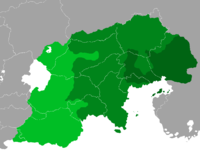Difference between revisions of "Nashaghan language"
Jump to navigation
Jump to search
m |
m |
||
| Line 46: | Line 46: | ||
}} | }} | ||
'''Nashaghan''' is a pluricentric [[Vaniuan languages|Vaniuan]] language in [[Vaniua]], descended from Proto-Eastern-Vaniuan and Kalkali, with about 55 million native speakers and official status in [[Komania]] (known locally as Hazarva), [[Balakia]] (known locally as Toroshghani), [[Gushlia]], (known locally as Marahi) and in [[Zinsha-Vogia]] (known locally as Nehir). Except for the Balak variant, all variants are notable for the sizable amount of dialects. It is written using the Vaniuan alphabet, the Najagh script and the Komani alphabet. | |||
==History== | ==History== | ||
| Line 92: | Line 93: | ||
|} | |} | ||
[[Category:Languages]][[Category:Vaniuan languages]][[Category:Balakia]][[Category:Gushlia]][[Category:Komania]][[Category:Zinsha-Vogia]] | [[Category:Languages]][[Category:Vaniuan languages]][[Category:Languages of Balakia]][[Category:Gushlia]][[Category:Komania]][[Category:Zinsha-Vogia]] | ||
Revision as of 21:33, 30 January 2021
| Nashaghan | |
|---|---|
| Nâshağan . Nashağan . | |
| Native speakers | ~55 million (2001 census – 2015) |
| Language family | Vaniuan
|
| Early forms: | Proto-Vaniuan
|
| Standard forms | |
| Dialects | |
| Writing system | Vaniuan Najagh script (Komani alphabet) |
| Official status | |
| Official language in | (as Hazarva, various dialects) (as Toroshghani) (as Marahi, various dialects) (as Nehir, various dialects) |
| Regulated by | Koman National Agency (Hazarva, Komania); ? (Toroshghani, Balakia); ? (Mahari, Gushlia) |
| CWS code | – |
 Sprachraum of the Nashaghan language throughout the Great Horde Western dialect Central dialect Eastern dialect | |
|
| |
Nashaghan is a pluricentric Vaniuan language in Vaniua, descended from Proto-Eastern-Vaniuan and Kalkali, with about 55 million native speakers and official status in Komania (known locally as Hazarva), Balakia (known locally as Toroshghani), Gushlia, (known locally as Marahi) and in Zinsha-Vogia (known locally as Nehir). Except for the Balak variant, all variants are notable for the sizable amount of dialects. It is written using the Vaniuan alphabet, the Najagh script and the Komani alphabet.
History
Names
Literature
Official status
Phonology
Grammar
Vocabulary
Writing system
Sample text
See also
| English | fire | month | new | mother | sister | night | nose | three | red | yellow | green | horse |
|---|---|---|---|---|---|---|---|---|---|---|---|---|
| Western Nashaghan | wo [wo] |
boh [woh] |
hadjar / haj [hɒdʒɒr] |
mâshæ [mɒːʃæ] |
shan [ʃɒ] |
bôhd [βoːð] |
nîn / nîm [nʲin] |
mêza [mʲæsä] |
dəsh [dəʃ] |
shâda [ʃɒːðä] |
shêdan [ʃəːðän] |
wurəm [wurəm] |
| Central Nashaghan | wo [wo] |
bôh [wuː] |
hadjar / haj [hɒdʒɒr] |
mâshæ [mɒːʃɛ] |
san [sɒ] |
bôhd [βuːð] |
nem [nem] |
mæza [mæzä] |
təz [təz] |
shaza [ʃɒzä] |
shəzan [ʃəːzän] |
wurəm [wurəm] |
| Eastern Nashaghan | wu [wu] |
bôh [wuː] |
hajj [hɑdz] |
mâshe [mɑːʃe] |
shan [ʃɑ] |
bôhd [wuːð] |
nem [nem] |
meza [mezä] |
təshe / dəshe [tɯʃe] |
shâda [ʃɑːðä] |
shêdan [ʃɯːðän] |
wurəm [wurɯm] |
| Modern Koman | wo [βo] |
woh [βoː] |
hajar / haj [häʒär] |
mâşe [mɒːʂe̞] |
şa [ʂɒ] |
bahḍ [βɒːð] |
nîn / nîm [nʲin] |
mêza [mʲe̞zä] |
təse / dəşe [təse] |
saja [sɒʒä] |
şêzan [ʂəːzän] |
wûrəm [βuːrəm] |
| Balak | vu / vuğas [vʊ] / [vʊɣɑs] |
- [] |
yar [jɑɾ] |
báş [baʃ] |
son [sɔn] |
vud [vʊd] |
ném [nem] |
bezá [bɛza] |
tes [tɛs] |
- [] |
- [] |
virem [vɪɾɛm] |
| Khezian | va [βu] |
ctasu [ʃtɐsu] |
anar [ɐnäs] |
maja [mäʒɐ] |
urva [urvɐ] |
carv [ʃɐrv] |
ciy [ʃɪ] |
bez [bɪz] |
dor [dʊs] |
uafisi [u:fɪsɪ] |
zota [zotɐ] |
vir [vis] |
| Vucheshian | vo [βɔ] |
fağâ [ɸɑʁʌ̽] |
- [] |
maye [mɑjɛ] |
- [] |
- [] |
- [] |
- [] |
tısı [tɯ̽sɯ̽] |
- [] |
- [] |
vuli [βʊlɪ] |
| Northern Vucheshian | vā [vɒː] |
fağā [fɒɰɒː] |
- [] |
mane [mɒnə] |
- [] |
- [] |
- [] |
- [] |
tiṣi [tisi] |
- [] |
- [] |
vuyēm [vʉʝəːm] |
| Vosan | va [va] |
conås [ʃonɒs] |
ane [ane] |
mance [manʃe] |
esâ [esja] |
car [ʃas] |
cî [ʃji] |
bes [bes] |
duro [duro] |
zanesîd / ağlîd [zanesjid] |
zoltâ [zoltja] |
vurô [vurjo] |